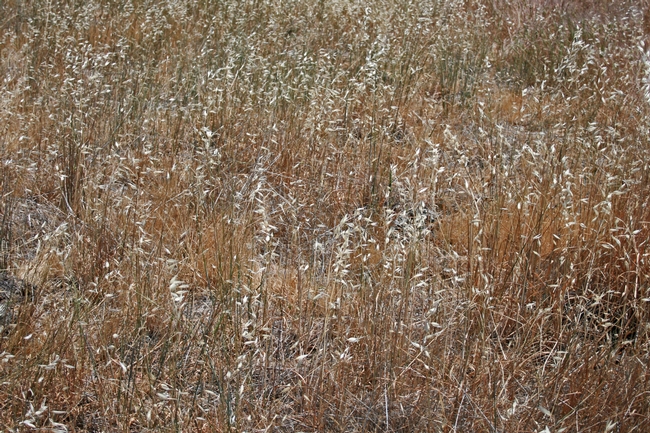The Mediterranean annual grass barb goatgrass (Aegilops triuncialis) is widely hated by land managers, and with good reason. Grazers avoid its tough, silica-rich foliage. In early summer it produces big, centipede-like, spiny-awned seedheads, which we call “crotch rockets” on account of what they do when they get inside your pants leg. Barb goatgrass is also tolerant of serpentine soils, presenting a threat to some California endemic species. Many ranchers consider this grass a greater problem than medusahead.
As with any invasive grass, it is difficult to selectively remove barb goatgrass from grasslands. Because it goes to seed late in the season, after most desirable species have dropped their seed, it is possible to control barb goatgrass seed production by burning in early summer (DiTomaso et al. 2001). However, because barb goatgrass seeds are viable for two years, the field must be burned a second year as well. It’s not always possible to get burn permits, and in the second year the field may not carry a reliable fire. Mowing and spot application of herbicides have been effective on a small scale (Aigner and Woerly 2011).
We’ve been doing thistle control trials with aminocyclopyrachlor, an experimental chemical from DuPont. This is a selective auxin-type herbicide with very little effect on most grasses. However, we heard a rumor that aminocyclopyrachlor might have a suppressive effect on barb goatgrass when applied preemergence. So we established a trial near Red Bluff to test it.

The test site was heavily infested, with an average 47% cover of barb goatgrass and 14% other annual grasses. We set up 10 ft by 30 ft plots in four replications and made treatments with a CO2 backpack sprayer. We applied aminocyclopyrachlor at two rates in October 2011, January 2012, and April 2012, as well as a split treatment with a low rate applied in both October and January. (We also tried some other chemicals, but let’s stick with aminocyclopyrachlor for now.)
In June 2012 we evaluated percent cover of all plant species in three 1-m2 quadrats per plot (see table). At all times of application, rates of 2 oz a.i. aminocyclopyrachlor/acre reduced barb goatgrass cover to 41% to 48% compared to untreated plots (~50% to 60% control). Rates of 4 oz a.i./acre reduced barb goatgrass to 9% to 13% of untreated plots (~90% control). Interestingly, the split application of 2 oz in October followed by 2 oz in January (4 oz total) gave better than 99% control. The October and October/January applications resulted in 3.1x to 4.7x increases in the cover of other, more desirable annual grasses.
|
Timing |
Chemical |
Rate (oz a.i./acre) |
Plant cover (% of untreated) |
|
|
Barb goatgrass |
Other annual grasses |
|||
|
October |
aminocyclopyrachlor |
2 |
41 |
313 |
|
October |
aminocyclopyrachlor |
4 |
12 |
467 |
|
Oct + Jan |
aminocyclopyrachlor |
2 + 2 |
0.5 |
359 |
|
January |
aminocyclopyrachlor |
2 |
41 |
149 |
|
January |
aminocyclopyrachlor |
4 |
13 |
82 |
|
April |
aminocyclopyrachlor |
2 |
48 |
122 |
|
April |
aminocyclopyrachlor |
4 |
9 |
133 |
|
none |
none |
none |
100 |
100 |

These results show potential for using aminocyclopyrachlor to selectively remove barb goatgrass from rangeland. Although the best treatment (split application) essentially prevented seed production, barb goatgrass has a two-year seed cycle, so the treatment would have to be repeated in order to deplete the seedbank. An effective integrated management approach might be to conduct a prescribed burn during summer, followed by aminocyclopyrachlor treatment in fall and winter; this would prevent seed production for two successive years, which should bring the barb goatgrass population down to the point where it can be managed by cultural practices. Similar integrated strategies have proved very effective in managing yellow starthistle (DiTomaso et al. 2006).
The future registration status of aminocyclopyrachlor is uncertain. It is not available in California at present, owing to unresolved concerns over risks to tree roots. In other states, it is only available in formulations premixed with sulfonylurea herbicides, which we have found somewhat injurious to desirable grasses. We’ll be continuing to communicate with CDPR and DuPont regarding registration of this chemical. Maybe someday we can get these crotch rockets out of our – well, our fields.
References
Aigner, P.A., and R.J. Woerly. 2011. Herbicides and mowing to control barb goatgrass (Aegilops triuncialis) and restore native plants in serpentine grasslands. Invasive Plant Science and Management 4:448-457.
DiTomaso, J.M., K.L. Heise, G.B. Kyser, A.M. Merenlender, and R.J. Keiffer. 2001. Carefully timed burning can control barb goatgrass. California Agriculture 55(6):47-53.
DiTomaso, J.M., G.B. Kyser, J.R. Miller, S. Garcia, R.F. Smith, G. Nader, J.M. Connor, and S.B. Orloff. 2006. Integrating prescribed burning and clopyralid for the management of yellow starthistle (Centaurea solstitialis). Weed Science 54:757-767.

